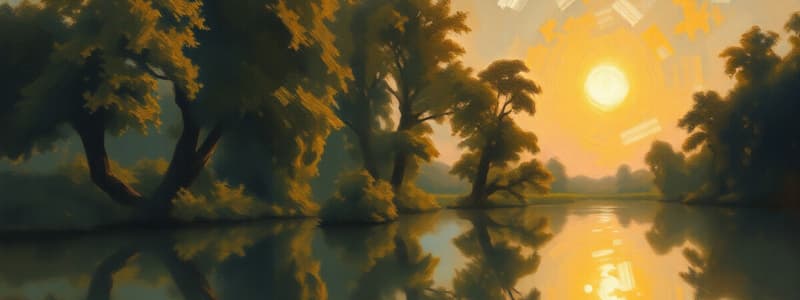Podcast
Questions and Answers
What distinguishes the medium of painting from other forms of art?
What distinguishes the medium of painting from other forms of art?
- It requires physical touch to create
- It exclusively uses auditory elements
- It is limited to only visual expression
- It conveys meaning through color and pigment on a flat surface (correct)
Which of the following mediums is known for being a rapid-drying paint characterized by its film-forming properties?
Which of the following mediums is known for being a rapid-drying paint characterized by its film-forming properties?
- Tempera (correct)
- Pastel
- Fresco
- Watercolor
How does technique differ among artists using the same medium, such as a pianist?
How does technique differ among artists using the same medium, such as a pianist?
- An artist's expression and skill can produce different sounds or effects (correct)
- Technique is solely based on the type of medium
- Technique does not vary with the same instruments
- All musicians achieve the same sound when playing together
Which medium is characterized by its difficulty to handle yet invites brilliance and variety of hues?
Which medium is characterized by its difficulty to handle yet invites brilliance and variety of hues?
What must an artist do to achieve the desired effect with their medium?
What must an artist do to achieve the desired effect with their medium?
Which painting medium is known for its slow drying time and flexibility?
Which painting medium is known for its slow drying time and flexibility?
What is a primary feature of mosaics in Byzantine churches?
What is a primary feature of mosaics in Byzantine churches?
What is the primary purpose of stained glass in Gothic cathedrals?
What is the primary purpose of stained glass in Gothic cathedrals?
Which medium is primarily used for training artists through line work and shading?
Which medium is primarily used for training artists through line work and shading?
During which period was tapestry primarily used for warmth and decoration in palaces and cathedrals?
During which period was tapestry primarily used for warmth and decoration in palaces and cathedrals?
Flashcards are hidden until you start studying
Study Notes
Art Mediums
- Artists use various materials, or mediums, to express feelings and thoughts.
- Arts are classified into two main categories: visual (seen) and auditory (heard).
- Visual arts can be two-dimensional (like paintings) or three-dimensional (like sculptures).
- Auditory arts are expressed over time, examples include music and literature.
- Combined arts include mediums that incorporate both visual and auditory elements, such as opera and film.
Technique
- Technique refers to how an artist controls their medium to create the desired effect.
- It encompasses the technical skills required for executing a specific artwork.
- Artists may use multiple mediums to enrich their creative expression and meaning.
- The choice of medium often depends on the artist's personal affinity and understanding of it.
The Artist and Their Medium
- The nature of the medium influences how the artwork is realized (e.g., stone requires chiseling, metal casting, wood carving).
- Artists must have a deep respect for their chosen medium to realize their vision effectively.
- Selection of medium can also impact the aesthetic and conceptual direction of the artwork.
The Artist and Their Technique
- Variability in technique exists among artists even when using the same medium; for instance, pianists playing the same piece sound different due to individual techniques.
- Technique can differ across different kinds of art; an artist may excel in one medium while struggling in another.
- For artists, technique is a means to an end, while for craftsmen, it represents the primary focus.
Painting
- Painting involves creating effects on flat surfaces using pigments.
- Watercolor is known for its brilliance but can be difficult to handle, often resulting in less luminous colors.
- Fresco is a quick painting method on moist plaster, utilizing water-based pigments.
- Tempera consists of mineral pigments mixed with egg yolk or white, noted for fast drying and film-forming properties.
- Pastel is a pigment stick combined with chalk, offering flexibility but less popularity.
- Encaustic is an ancient wax-based painting medium, fixed with heat.
- Oil paint is heavy, flexible, and dries slowly, allowing for detailed work.
- Acrylic is popular among contemporary painters, known for durability.
Mosaic
- Mosaic art involves creating images with small pieces of colored stones or glass (tesserae) set in plaster or cement.
- Commonly featured in Byzantine churches, it served religious purposes.
- Stained glass, made by combining colored glass pieces, is also prevalent in Gothic cathedrals, often depicting saints and used for religious education.
Tapestry
- Tapestry is created by hand-weaving colored threads into fabric, often depicting narratives or images.
- It provided warmth and decorative elements in palaces and churches during the Middle Ages.
Drawing
- Drawing utilizes mediums such as pencil, pen and ink, and charcoal.
- It is foundational for artist training, emphasizing line work, shading, and realistic representation skills.
Studying That Suits You
Use AI to generate personalized quizzes and flashcards to suit your learning preferences.




